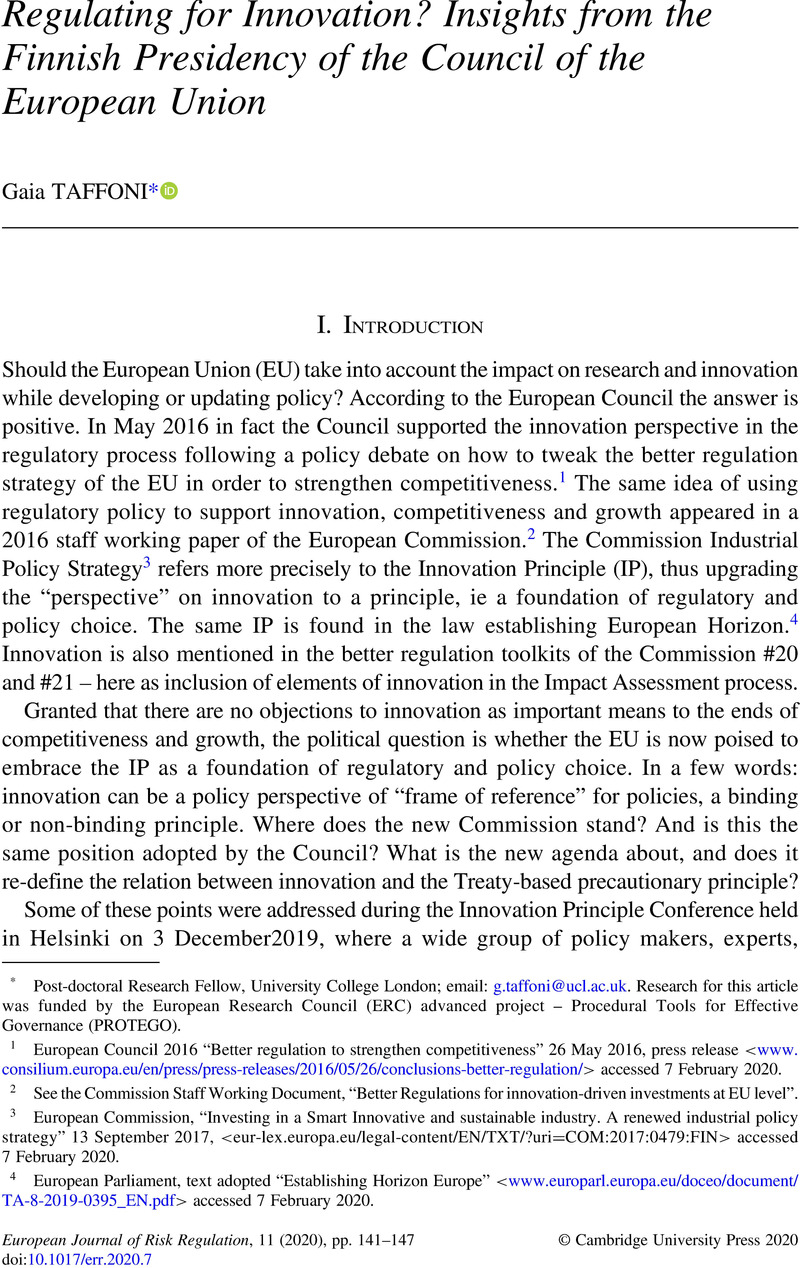Published online by Cambridge University Press: 30 March 2020

Research for this article was funded by the European Research Council (ERC) advanced project – Procedural Tools for Effective Governance (PROTEGO).
1 European Council 2016 “Better regulation to strengthen competitiveness” 26 May 2016, press release <www.consilium.europa.eu/en/press/press-releases/2016/05/26/conclusions-better-regulation/> accessed 7 February 2020.
2 See the Commission Staff Working Document, “Better Regulations for innovation-driven investments at EU level”.
3 European Commission, “Investing in a Smart Innovative and sustainable industry. A renewed industrial policy strategy” 13 September 2017, <eur-lex.europa.eu/legal-content/EN/TXT/?uri=COM:2017:0479:FIN> accessed 7 February 2020.
4 European Parliament, text adopted “Establishing Horizon Europe” <www.europarl.europa.eu/doceo/document/TA-8-2019-0395_EN.pdf> accessed 7 February 2020.
5 In particular, for scholarly works on innovation principle see A Portuese and J Pillot, “The Case for an Innovation Principle: A Comparative Law and Economics Analysis” (2018) 15 Manchester Journal of International Economic Law 2014.
6 Scholarly works on innovation and legislation include, among others, works on the legal and regulatory problems at the technological frontiers: see for instance L Bennett Moses, “How to Think about Law, Regulation and Technology: Problems with Technology as a Regulatory Target” (2015) 5(1) Law Innovation and Technology 1. A reflection on how legislation can become more adaptable to innovation is provided in S Ranchordas and M van 't Schip, “Future-Proofing Legislation for the Digital Age” in S Ranchordas and Y Roznai (eds), Time, Law, and Change (Hart Publishing forthcoming).
7 K Garnett et al, “Towards an innovation principle: an industry trump or shortening the odds on environmental protection?” (2018) 10(1) Law, Innovation and Technology 1.
8 Council of the EU, 2016.
9 ibid.
10 European Commission, 2016 “Better Regulation for innovation-driven investment at EU level” <op.europa.eu/en/publication-detail/-/publication/404b82db-d08b-11e5-a4b5-01aa75ed71a1/language-en/format-PDF/source-79728021> accessed 7 February 2020.
11 See the description of EPSC at <ec.europa.eu/epsc/home_en> accessed 17 February 2020.
12 European Political Strategy Centre, Towards an Innovation Principle Endorsed by Better Regulation. EPSC Strategic Notes (2016).
13 ibid.
14 C Edquist, “Striving Towards a Holistic Innovation Policy in European Countries – But Linearity Still Prevails!” (2017) 5(2) STI Policy Review.
15 Corporate Europe Observatory, “Innovation Principle” <corporateeurope.org/en/2019/12/finnish-presidency-dedicates-high-level-conference-innovation-principle-pushed-corporate> accessed 7 February 2020.
16 See the complete definition of PP at <eur-lex.europa.eu/summary/glossary/precautionary_principle.html> accessed 7 February 2020.
17 ERF, The Precautionary Principle. Application and Way Forward (2011) <www.riskforum.eu/uploads/2/5/7/1/25710097/erf_pp_way_forward_booklet_.pdf> accessed 7 February 2020.
18 JM Leceta et al, Unleashing Innovation and Entrepreneurship in Europe, People Places and Policies (CEPS 2017) <aei.pitt.edu/84485/1/TFR_Innovation_final.pdf> accessed 7 February 2020.
19 CEPS Final Report, Renda et al, 5 December 2019 <www.bmwi.de/Redaktion/DE/Publikationen/Studien/final-report-oioo-ceps.html> accessed 7 February 2020.